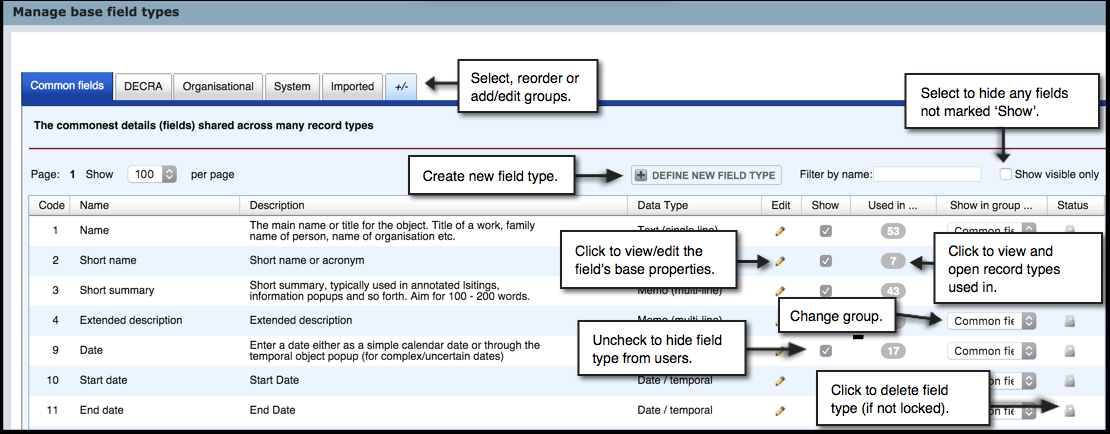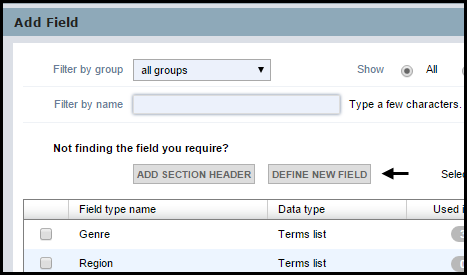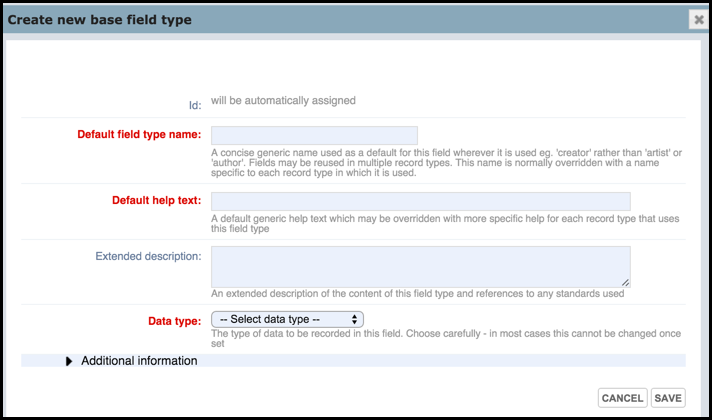When creating a record definition you can re-use previously created base field types; this is recommended where a suitable field type already exists. However, if no suitable field type exists you can create a new one for insertion into your record type, and which then becomes available for adding to other record types.
Create a New Field Type
When creating a new field type you choose from a range of underlying data types that cover a wide range of data requirements, such as single or multi line text, numeric, date/temporal, term lists (see below), geospatial etc.
You can also define how to link records together via two specialised field types: Record Pointer and Relationship Markers (see Relate).
When creating a new field type you can add a description, help text and control visibility and grouping.
You can reuse new field types across the database or other databases, with the ability to tailor instances of the fields per record type, as well as controlling field expression/usage (e.g. required, recommended or optional, single or repeatable values etc.).
Note. A 'base field type' is any field type available when creating any record structure. Any new field type you create is automatically added to the set of base field types. The field type expression refers to the use of a field type in a particular record structure; in this case additional properties can be set for that instance (such as the field name).
When you choose to use a field type (either pre-defined or user-defined) within a record, you can further define its behaviour in this particular instance (its 'field expression') through additional settings. See Set Field Behaviour (Expression).
To create a new field type
The Manage Base Field Types screen displays:

Note. If you are defining a new field type to be added to a particular record type, open the Add Field dialog (see Edit Record Structure), and select Define New Field.


Id |
A unique field ID is automatically assigned when you save the field type. |
Default field type name |
Enter a name for the field type. Remember that you are creating a field type that can be reused in multiple record types; so use a generic name. When you use the field type in a record you will probably change the name to something more specific to that record type. For example, Book rather than Novel. (See also Edit Field Expression below.) Note: For record type and field type names, the following symbols are allowed: a-zA-Z0-9$_<> /,–— The last two symbols are n-dash (150) and m-dash (151). Minus/hyphen symbols are not allowed. |
Default help text |
Enter default help text (this may be overridden or edited when used in a specific record type expression). |
Extended Description |
Enter any additional information about this field, useful to you or other database designers. (Not seen by the user.) |
Data Type |
Select a suitable data type (see Data Types). The settings here will determine what the user will actually see in the data entry/edit form for records of that type (prompt, help text, field width) and constraints on the values that can be edited (required, minimum/maximum number of values etc.). Field types you will need to supply additional information for include:
(These are described in the subtopics.) Note. You are limited in what Data Type changes you can make and in most cases you cannot change this. The following data types are for structuring your fields and contain no data:
Tip. Use these, along with the position of the field types in the record structure page, to properly layout your record in the data input page. |
Display Group |
Select the group the field type is to belong to. (Field types are grouped together into related types for easier management). To add new groups, click the +/- tab. You can change this group at any time. |
Status |
This can be:
|
Non-Owner Visibility |
This can be:
|
Show in Lists |
Select this checkbox to make the field type available to the user (e.g. in dropdown menus) or un-select to temporally hide the record type. |
Important: Any changes to a field type will propagate into any fields already created within your record structures.
Created with the Personal Edition of HelpNDoc: Easy to use tool to create HTML Help files and Help web sites